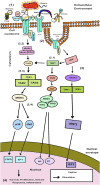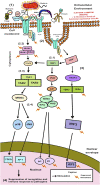The relationship between 896A/G (rs4986790) polymorphism of TLR4 and infectious diseases: A meta-analysis
- PMID: 36506333
- PMCID: PMC9729345
- DOI: 10.3389/fgene.2022.1045725
The relationship between 896A/G (rs4986790) polymorphism of TLR4 and infectious diseases: A meta-analysis
Abstract
Toll-like Receptors (TLRs), such as the TLR4, are genes encoding transmembrane receptors of the same name, which induce a pro- or anti-inflammatory response according to their expression as the host's first line of defense against pathogens, such as infectious ones. Single nucleotide polymorphisms (SNPs) are the most common type of mutation in the human genome and can generate functional modification in genes. The aim of this article is to review in which infectious diseases there is an association of susceptibility or protection by the TLR4 SNP rs4986790. A systematic review and meta-analysis of the literature was conducted in the Science Direct, PUBMED, MEDLINE, and SciELO databases between 2011 and 2021 based on the dominant genotypic model of this SNP for general and subgroup analysis of infectious agent type in random effect. Summary odds ratios (ORs) and corresponding 95% confidence intervals (CIs) were calculated for genotypic comparison. I2 statistics were calculated to assess the presence of heterogeneity between studies and funnel plots were inspected for indication of publication bias. A total of 27 articles were included, all in English. Among the results achieved, the categories of diseases that were most associated with the SNP studied were in decreasing order of number of articles: infections by bacteria (29.63%); caused by viruses (22.23%); urinary tract infection-UTI (7.4%), while 11 studies (40.74%) demonstrated a nonsignificant association. In this meta-analysis, a total of 5599 cases and 5871 controls were finalized. The present meta-analysis suggests that there is no significant association between TLR4-rs4986790 SNP and infections (OR = 1,11; 95% CI: 0,75-1,66; p = 0,59), but in the virus subgroup it was associated with a higher risk (OR = 2,16; 95% CI: 1,09-4,30; p = 0,03). The subgroups of bacteria and parasites did not show statistical significance (OR = 0,86; 95% CI: 0,56-1,30; p = 0,47, and no estimate of effects, respectively). Therefore, it has been shown that a diversity of infectious diseases is related to this polymorphism, either by susceptibility or even severity to them, and the receptor generated is also crucial for the generation of cell signaling pathways and immune response against pathogens.
Keywords: association studies; immunogenetics; infectious diseases; single nucleotide polymorphism; toll-like receptor 4 (TLR4).
Copyright © 2022 Silva, Santana, de Oliveira, Monteiro and Lima.
Conflict of interest statement
The authors declare that the research was conducted in the absence of any commercial or financial relationships that could be construed as a potential conflict of interest.
Figures






References
-
- Acorci-Valério M. J., Bordon-Graciani A. P., Dias-Melicio L. A., De Assis Golim M., Nakaira-Takahagi E., De Campos Soares Â. M. V. (2010). Role of TLR2 and TLR4 in human neutrophil functions against Paracoccidioides brasiliensis. Scand. J. Immunol. 71, 99–108. 10.1111/j.1365-3083.2009.02351.x - DOI - PubMed
-
- Aguirre-García M. M., Rojas-Bernabé A., Gómez-García A. P., Escalona-Montaño A. R. (2019). TLR-mediated host immune response to parasitic infectious diseases. IntechOpen. 10.5772/intechopen.84679 - DOI
Publication types
LinkOut - more resources
Full Text Sources

